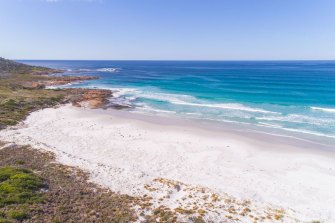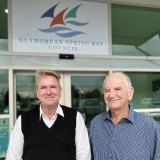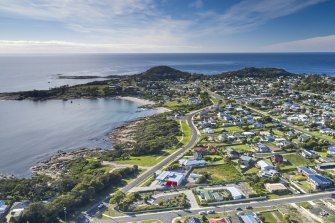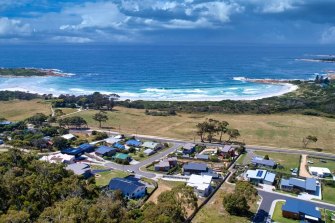“[Houses] have seen such a price gain, that a lot of people don’t rent them out, they sell them, or rent them on the short-term letting market.”
The region has long had holiday properties, but this has ticked higher. More than half of households, 53 per cent, were unoccupied on Census night last August, up from 46.5 per cent in 2001. The population increased by 976 people to 5012 in that time – and by more than 600 people since 2016 – and the number of private dwellings counted increased by more than 1,400 to 4,722 households.

Sea-changers have been drawn to Tasmanian towns such as Bicheno.
Census data shows the median rental price was $250 per week last August, up from $160 in 2011.
The proportion of tenants putting more than 30 per cent of income towards rent more than quadrupled in that time, hitting 31.7 per cent.
Council’s general manager Greg Ingham is well aware of the housing shortage. He has been renting a one-bedroom cabin in a caravan park with his wife from him since he moved to the area almost two years ago.

Glamorgan-Spring Bay Council general manager Greg Ingham and Major Robert Young.
“I like to live in the community where I’m working… and it was the only thing available,” he said.
He was fortunate to get anywhere, he said, with other staff commuting long distances due to a lack of affordable homes. This was making it hard for councils and businesses to attract staff.
“The Airbnb market is not helping, that had a negative impact in terms of availability to the ordinary couple or family looking for a place,” he said. “It’s a concern shared with all the local government areas.”
But there’s no simple solution. Young said any limits or higher taxes on short-term rentals would need to be carefully considered, given some 50 per cent of the municipality’s income was from tourism.
Both would like to see more residential development in the area, particularly affordable housing, but new land had been in short supply with rezoning limited by state planning schemes.
Airbnb has previously said that local businesses rely on tourism dollars spent by short-stay guests, and that a range of issues contribute to housing affordability such as long-term population shifts and supply growth.

More than half of homes in the picturesque region were empty on Census night last year.
KPMG demographer and urban economist Terry Rawnsley said Tasmania’s housing market had grown as the state made a name for itself with its food and wine scene, MONA and Dark Mofo.
With limited housing supply, it did not take much population growth to soak up the available homes and put pressure on prices.
loading
In a perfect world, land would have been reasoned five years ago when the surge began, he said.
“You would have fed the market. But [now] you’re playing catch up.”
Council recently sold land to community housing provider Centacare Evolve Housing, which will build 18 apartments. Another six units will be delivered in Swansea, adding to the dozen properties the provider has in the area.
Centacare Evolve Housing chief executive Ben Wilson said more social and affordable housing needed to be built across the state. Almost 4,500 people were on the social housing waiting list, nearly 50 per cent of whom were priority applicants, and shelters were having to turn away hundreds of people seeking emergency accommodation.
“Significant pressures in the private market have driven rents up, while people may still be housed, they may be in significant financial stress where 40 or 50 per cent of their income is going towards rent,” he said.

Half of homes were empty on Census night on this stretch of Tasmania’s east coast.
He welcomed the Tasmanian government’s commitment to build 10,000 affordable homes by 2032, and partnerships with local councils to boost supply.
Knight Frank Tasmania sales consultant Leanne Dann said the property market had been “absolutely insane” over the past year, with homes getting multiple offers before being advertised during the peak.
Price growth in areas like Swansea, Coles Bay and Dolphin Sands had been largely driven by Tasmanians buying holiday and secondary homes. Towns like Bicheno had seen more interest from mainland tree changers, including young families. About two thirds of properties sold to holiday home buyers or investors.
Sales agent Paul Whytcross, of Roberts Real Estate Bicheno, said the true impact of rising rates would not be seen until spring, when more homes are typically listed for sale.
“[Buyer demand] has eased off, we’re in depths of a Tassie winter, but limited stock is coming onto the market, and with that… the inquiry rate is still relatively strong. But the phones aren’t ringing off the hook [any more],” he said.
While first homebuyers had always been rare in the region, he felt for young people priced out.
“There’s definitely concern going forward for how young ones will get into the market here, even as far as permanent rentals go, there’s a lot of work in the area …but the accommodation is limited.”
With Tawar Razaghi
The Morning Edition newsletter is our guide to the day’s most important and interesting stories, analysis and insights. Sign up here.

